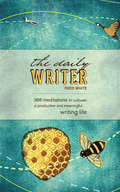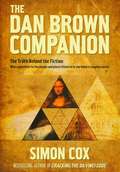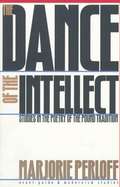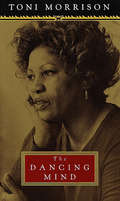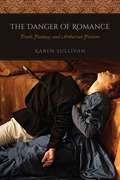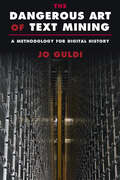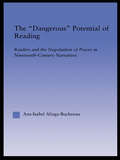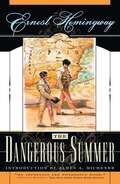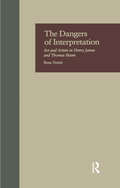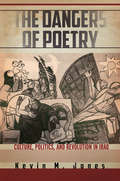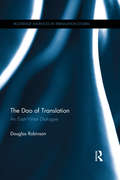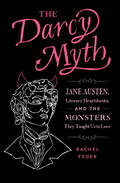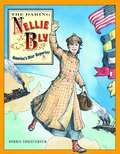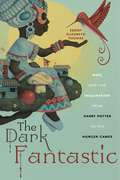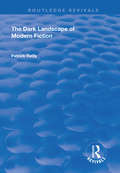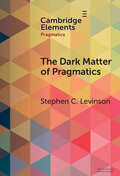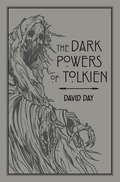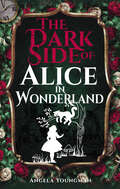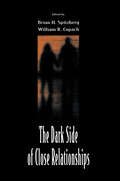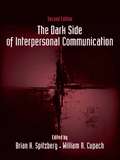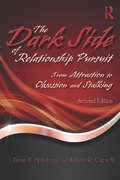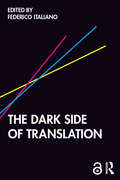- Table View
- List View
The Daily Writer: 366 Meditations to Cultivate a Productive and Meaningful Writing Life
by Fred WhiteMake Writing a Part of Your Daily Routine It isn't always easy to carve out time to devote meaningful thought and energy to your writing. Hectic schedules, distractions, and creative blocks all too often interrupt the dream - postpone it for another day. But with 366 provocative entries - each addressing a specific facet of the writing craft, and accompanied by an in-depth reflection and a stimulating exercise -The Daily Writerprovides you with easy entry points into that elusive space where words matter most and helps you to embrace writing as a way of seeing the world. Whether you're looking for a way to better integrate writing into your life, get warmed up before you dive into a bigger work in progress, or overcome an old case of writer's block,The Daily Writercan help you establish and maintain an inspired devotion to the craft.
The Dan Brown Companion
by Simon CoxWith its in-depth look at some of the themes and real-life stories behind the fiction, The Dan Brown Companion gives a unique insight into the world of one of the most successful bestselling novelists of our time.A huge Dan Brown following has emerged, determined to walk in the footsteps of his lead character Robert Langdon and to delve deeper into the fiction. Simon Cox, bestselling author of Cracking the Da Vinci Code and Illuminating Angels and Demons, now brings us this definitive guide.Questions are answered and plots thickened as we look for the clues that inspired Dan Brown. From the death of popes to the Priory of Sion, the mystery of Rennes-le-Château to the Illuminati, all the facts are finally laid bare.The Dan Brown Companion is an exceptional guide to the real world of mystery and intrigue that lies at the heart of the Robert Langdon novels and is a must-have for all Dan Brown fans.
The Dance of the Intellect: Studies in the Poetry of the Pound Tradition
by Marjorie PerloffMust poetic form be, as Yeats demanded, "full, sphere-like, single", or can it accommodate the "impurities" Yeats and his Modernist generation found so problematic? Sixty years later, these are still open questions, questions to which Marjorie Perloff addresses herself in the essays collected here. The first group of essays deals with Pound's own poetics as that poetics related to two of his great contemporaries, Stevens and Joyce, as well as to the visual arts of his day. The second group deals with the more technical aspects of verse and prose. In the last four essays, Perloff takes up broader issues, including the current pessimism about the state of poetry, and the work of experimental poets and conceptual poets.
The Dancing Mind
by Toni MorrisonOn the occasion of her acceptance of the National Book Foundation Medal for Distinguished Contribution to American Letters on the sixth of November, 1996, Nobel laureate Toni Morrison speaks with brevity and passion to the pleasures, the difficulties, the necessities, of the reading/writing life in our time.
The Danger of Romance: Truth, Fantasy, and Arthurian Fictions
by Karen SullivanThe curious paradox of romance is that, throughout its history, this genre has been dismissed as trivial and unintellectual, yet people have never ceased to flock to it with enthusiasm and even fervor. In contemporary contexts, we devour popular romance and fantasy novels like The Lord of the Rings, Harry Potter, and Game of Thrones, reference them in conversations, and create online communities to expound, passionately and intelligently, upon their characters and worlds. But romance is “unrealistic,” critics say, doing readers a disservice by not accurately representing human experiences. It is considered by some to be a distraction from real literature, a distraction from real life, and little more. Yet is it possible that romance is expressing a truth—and a truth unrecognized by realist genres? The Arthurian literature of the Middle Ages, Karen Sullivan argues, consistently ventriloquizes in its pages the criticisms that were being made of romance at the time, and implicitly defends itself against those criticisms. The Danger of Romance shows that the conviction that ordinary reality is the only reality is itself an assumption, and one that can blind those who hold it to the extraordinary phenomena that exist around them. It demonstrates that that which is rare, ephemeral, and inexplicable is no less real than that which is commonplace, long-lasting, and easily accounted for. If romance continues to appeal to audiences today, whether in its Arthurian prototype or in its more recent incarnations, it is because it confirms the perception—or even the hope—of a beauty and truth in the world that realist genres deny.
The Dangerous Art of Text Mining: A Methodology for Digital History
by Jo GuldiThe Dangerous Art of Text Mining celebrates the bold new research now possible because of text mining: the art of counting words over time. However, this book also presents a warning: without help from the humanities, data science can distort the past and lead to perilous errors. The book opens with a rogue's gallery of errors, then tours the ground-breaking analyses that have resulted from collaborations between humanists and data scientists. Jo Guldi explores how text mining can give a glimpse of the changing history of the past - for example, how quickly Americans forgot the history of slavery. Textual data can even prove who was responsible in Congress for silencing environmentalism over recent decades. The book ends with an impassioned vision of what text mining in defence of democracy would look like, and why humanists need to be involved.
The Dangerous Potential of Reading: Readers & the Negotiation of Power in Selected Nineteenth-Century Narratives (Literary Criticism and Cultural Theory)
by Ana-Isabel Aliaga-BuchenauFirst Published in 2004. Routledge is an imprint of Taylor & Francis, an informa company.
The Dangerous Summer
by Ernest HemingwayThe Dangerous Summer is Hemingway's firsthand chronicle of a brutal season of bullfights. In this vivid account, Hemingway captures the exhausting pace and pressure of the season, the camaraderie and pride of the matadors, and the mortal drama as in fight after fight the rival matadors try to outdo each other with ever more daring performances. At the same time Hemingway offers an often complex and deeply personal self-portrait that reveals much about one of the twentieth century's preeminent writers.
The Dangers of Interpretation: Art and Artists in Henry James and Thomas Mann (Origins of Modernism #8)
by Ilona TreitelFirst published in 1996. This comparative study investigates thematic and technical similarities in the works of the two authors who shared a cultural heritage and achieved comparable status in their separate literary traditions. Drawing upon theories by Bloom, Bakhtin, and Lacan, the book examines ways in which Henry James and Thomas Mann treat the creative artist and analyze the creative and interpretive processes in their fiction. The texts covered range from early works to their great modern novels: The Golden Bowland Doctor Faustus To a great extent, the similarities between the works stem from the authors' preoccupation with artistic responsibility. Adopting Bloom's claim that the creative activity is an interpretive one, and that the reader, as well as the writer, interprets a text into being the book also investigates the reader's responsibility in confronting the dilemmas challenging James' and Mann's artist figures. Such challenges are "the dangers of interpretation" discussed in this book. Index. Bibliography.
The Dangers of Poetry: Culture, Politics, and Revolution in Iraq
by Kevin M. JonesPoetry has long dominated the cultural landscape of modern Iraq, simultaneously representing the literary pinnacle of high culture and giving voice to the popular discourses of mass culture. As the favored genre of culture expression for religious clerics, nationalist politicians, leftist dissidents, and avant-garde intellectuals, poetry critically shaped the social, political, and cultural debates that consumed the Iraqi public sphere in the twentieth century. The popularity of poetry in modern Iraq, however, made it a dangerous practice that carried serious political consequences and grave risks to dissident poets. The Dangers of Poetry is the first book to narrate the social history of poetry in the modern Middle East. Moving beyond the analysis of poems as literary and intellectual texts, Kevin M. Jones shows how poems functioned as social acts that critically shaped the cultural politics of revolutionary Iraq. He narrates the history of three generations of Iraqi poets who navigated the fraught relationship between culture and politics in pursuit of their own ambitions and agendas. Through this historical analysis of thousands of poems published in newspapers, recited in popular demonstrations, and disseminated in secret whispers, this book reveals the overlooked contribution of these poets to the spirit of rebellion in modern Iraq.
The Dao of Translation: An East-West Dialogue (Routledge Advances in Translation and Interpreting Studies)
by Douglas RobinsonThe Dao of Translation sets up an East-West dialogue on the nature of language and translation, and specifically on the "unknown forces" that shape the act of translation. To that end it mobilizes two radically different readings of the Daodejing (formerly romanized as the Tao Te Ching): the traditional "mystical" reading according to which the Dao is a mysterious force that cannot be known, and a more recent reading put forward by Sinologists Roger T. Ames and David L. Hall, to the effect that the Dao is simply the way things happen. Key to Ames and Hall’s reading is that what makes the Dao seem both powerful and mysterious is that it channels habit into action—or what the author calls social ecologies, or icoses. The author puts Daoism (and ancient Confucianism) into dialogue with nineteenth-century Western theorists of the sign, Charles Sanders Peirce and Ferdinand de Saussure (and their followers), in order to develop an "icotic" understanding of the tensions between habit and surprise in the activity of translating. The Dao of Translation will interest linguists and translation scholars. This book will also engage researchers of ancient Chinese philosophy and provide Western scholars with a thought-provoking cross-examination of Eastern and Western perspectives.
The Darcy Myth: Jane Austen, Literary Heartthrobs, and the Monsters They Taught Us to Love
by Rachel Feder&“A wildly entertaining read.&”—The Washington PostWhat if we've been reading Jane Austen and romantic classics all wrong? A literary scholar offers a funny, brainy, eye-opening take on how our contemporary love stories are actually terrifying.Covering cultural touchstones ranging from Normal People to Taylor Swift and from Lord Byron to The Bachelor, The Darcy Myth is a book for anyone who loves thinking deeply about literature and culture—whether it&’s Jane Austen or not.You already know Mr. Darcy—at least you think you do! The brooding, rude, standoffish romantic hero of Pride and Prejudice, Darcy initially insults and ignores the witty heroine, but eventually succumbs to her charms. It&’s a classic enemies-to-lovers plot, and one that has profoundly influenced our cultural ideas about courtship. But what if this classic isn&’t just a grand romance, but a horror novel about how scary love and marriage can be for women?In The Darcy Myth, literature scholar Rachel Feder unpacks Austen&’s Gothic influences and how they&’ve led us to a romantic ideal that&’s halfway to being a monster story. Why is our culture so obsessed with cruel, indifferent romantic heroes (and sometimes heroines)? How much of that is Darcy&’s fault? And, now that we know, what do we do about it?
The Daring Nellie Bly: America's Star Reporter
by Bonnie ChristensenFrom the award-winning picture book biographer of Woody Guthrie comes the inspirational story of Nellie Bly. Born in 1864, during a time in which options were extremely limited for women, Nellie defied all expectations and became a famous newspaper correspondent. Her daring exploits included committing herself to an infamous insane asylum in New York City to expose the terrible conditions there and becoming the first American war correspondent of either sex to report on the front lines of Austria during World War I. In 1889, Nellie completed her most publicized stunt, her world-famous trip around the world in just 72 days, beating the record of Jules Vernes’ fictional hero inAround the World in 80 Days. With an informative text and pen-and-ink illustrations reminiscent of the graphic style of the late 1800s,The Daring Nellie Blycaptures the independent spirit of America’s first star reporter, Nellie Bly. From the Hardcover edition.
The Dark Fantastic: Race and the Imagination from Harry Potter to the Hunger Games (Postmillennial Pop #13)
by Ebony Elizabeth ThomasWinner, 2022 Children's Literature Association Book Award, given by the Children's Literature AssociationWinner, 2020 World Fantasy AwardsWinner, 2020 British Fantasy Awards, NonfictionFinalist, Creative Nonfiction IGNYTE Award, given by FIYACON for BIPOC+ in Speculative FictionReveals the diversity crisis in children's and young adult media as not only a lack of representation, but a lack of imaginationStories provide portals into other worlds, both real and imagined. The promise of escape draws people from all backgrounds to speculative fiction, but when people of color seek passageways into the fantastic, the doors are often barred. This problem lies not only with children’s publishing, but also with the television and film executives tasked with adapting these stories into a visual world. When characters of color do appear, they are often marginalized or subjected to violence, reinforcing for audiences that not all lives matter. The Dark Fantastic is an engaging and provocative exploration of race in popular youth and young adult speculative fiction. Grounded in her experiences as YA novelist, fanfiction writer, and scholar of education, Thomas considers four black girl protagonists from some of the most popular stories of the early 21st century: Bonnie Bennett from the CW’s The Vampire Diaries, Rue from Suzanne Collins’s The Hunger Games, Gwen from the BBC’s Merlin, and Angelina Johnson from J.K. Rowling’s Harry Potter. Analyzing their narratives and audience reactions to them reveals how these characters mirror the violence against black and brown people in our own world. In response, Thomas uncovers and builds upon a tradition of fantasy and radical imagination in Black feminism and Afrofuturism to reveal new possibilities. Through fanfiction and other modes of counter-storytelling, young people of color have reinvisioned fantastic worlds that reflect their own experiences, their own lives. As Thomas powerfully asserts, “we dark girls deserve more, because we are more.”
The Dark Landscape of Modern Fiction
by Patrick ReillyThis title was first published in 2003. This text explores the "dark, pessimistic truth that pervades the pages of modern texts", setting a theme of Dante's "Inferno" against the work of modern authors including Dostoyevsky, Hardy, Conrad, Wharton, Kafka, Camus, Waugh and Flannery O'Connor. The author's thesis is that these writers exhibit a hostility towards the reader, an anger that the reader should continue to be so deludedly happy when the writer has become so mortifyingly enlightened. At its most characteristic, Reilly demonstrates, modern fiction seems to achieve a savage satisfaction in inflicting this pain, to an extent that could be described as sadistic. Reilly traces what he calls this "punitive spirit" to a character in the "Inferno", Vanni Fucci, who suffering himself does his best to make Dante suffer too. Through the study he uses the "Inferno" as a guide to the prevailing attitudes in modern fiction, revealing a parallel between the prohibition of pity within the medieval poem and in the pages of modern texts.
The Dark Matter of Pragmatics: Known Unknowns (Elements in Pragmatics)
by Stephen C. LevinsonThis Element tries to discern the known unknowns in the field of Pragmatics, the 'Dark Matter' of the title. The authors can identify a key bottleneck in human communication, the sheer limitation on the speed of speech encoding: Pragmatics occupies the niche nestled between slow speech encoding and fast comprehension. Pragmatic strategies are tricks for evading this tight encoding bottleneck by meaning more than you say. Five such tricks are reviewed, which are all domains where the authors have made considerable progress. The authors can then ask for each of these areas, where have the authors neglected to push the frontier forward? These are the known unknowns of pragmatics, key areas, and topics for future research. The Element thus offers a brief review of some central areas of pragmatics, and a survey of targets for future research. This title is also available as Open Access on Cambridge Core.
The Dark Powers of Tolkien: An illustrated Exploration of Tolkien's Portrayal of Evil, and the Sources that Inspired his Work from Myth, Literature and History
by David DayJ.R.R. Tolkien's The Lord of the Rings, The Hobbit and The Silmarillion are some of the greatest tales of good versus evil ever told. From the creation of Arda to the War of the Ring, Tolkien's Middle-earth has seen war and rebellion, devastation and loss, in which the powers of darkness emerged. Here in his latest book, best-selling author and Tolkien expert David Day explores Tolkien's portrayal of evil, and the sources that inspired his work: from myth, literature and history. This work is unofficial and is not authorized by the Tolkien Estate or HarperCollins Publishers.
The Dark Powers of Tolkien: An illustrated Exploration of Tolkien's Portrayal of Evil, and the Sources that Inspired his Work from Myth, Literature and History (Tolkien)
by David DayJ.R.R. Tolkien's The Lord of the Rings, The Hobbit and The Silmarillion are some of the greatest tales of good versus evil ever told. From the creation of Arda to the War of the Ring, Tolkien's Middle-earth has seen war and rebellion, devastation and loss, in which the powers of darkness emerged. Here in his latest book, best-selling author and Tolkien expert David Day explores Tolkien's portrayal of evil, and the sources that inspired his work: from myth, literature and history. This work is unofficial and is not authorized by the Tolkien Estate or HarperCollins Publishers.
The Dark Side of Alice in Wonderland
by Angela YoungmanA unique exploration of the character, the author, and the many transformations of Alice in modern culture—often in edgy and menacing ways. The Dark Side of Alice in Wonderland is the first investigation of the vast range of darker, more threatening aspects of this famous story, and the way Alice has been transformed over time. Although the children&’s story has been in print for over 150 years, the mysteries and rumors surrounding the story and its creator Lewis Carroll have continued to grow. Alice has been transformed—this is the Alice of horror films, Halloween, murder and mystery, spectral ghosts, political satire, mental illnesses, weird feasts, Lolita, Tarot, pornography, and steampunk. The Beatles based famous songs such as &“Lucy in the Sky with Diamonds&” and &“I am the Walrus&” on Alice&’s Adventures in Wonderland, and she has even attracted the attention of world-famous artists including Salvador Dali. The Japanese version of Lolita is so different from that of novelist Vladimir Nabokov—yet both are based on Alice. This is Alice in Wonderland as you have never seen her before: a dark, sometimes menacing, and threatening character. Was Carroll all that he seemed? The stories of his child friends, nude photographs, and sketches affect the way modern audiences look at the writer. Was he just a lonely academic, a closet pedophile, a brilliant puzzle maker—or even Jack the Ripper? For a book that began life as a simple children&’s story, it has resulted in a vast array of dark concepts, ideas, and mysteries. With this book, you can step inside the world of Alice in Wonderland—and discover a dark side you never knew existed.
The Dark Side of Close Relationships
by William R. Cupach Brain H. SpitzbergThis collection of essays represents a follow-up to the editors' 1994 publication, The Dark Side of Interpersonal Communication. In the preface to that collection of essays, they argued that "To fully understand how people function effectively requires us to consider how individuals cope with social interaction that is difficult, problematic, challenging, distressing, and disruptive." In this companion volume, the focus expands from social interaction to close relationships. Aside from the inherent need to investigate the bad as well as the good of interpersonal relationships, the editors and their colleagues simply find the dark side metaphor to be intellectually arousing. It stimulates investigation of important yet often neglected phenomena, and it especially encourages consideration of the hidden and forbidden, and the paradoxical and ironic elements of human relating. This volume assembles the cutting-edge work of first rate scholars from the ranks of communication, psychology, sociology, and cognate disciplines. As in the previous text, the subject matter and stylistic approaches are diverse, reflecting the broad and interdisciplinary domain that is the dark side of human affairs. The selection of topics is somewhat selective, reflecting only a sample of emerging scholarship in the interdisciplinary study of relationships. These internationally recognized scholars examine various topics related to the dark side, including fatal attractions, jealousy and envy, misunderstanding, gossip, conflict, codependence, sexual coercion, stalking, relationship termination, unrequited love, and mental health problems in relationships. Some chapters present original data and models, whereas others reconfigure the way in which the understandings of relationships can be better understood. In addition, the bookend chapters examine the ideology, nature, and problems of dark side scholarship. Collectively, the scholarly journeys made in this volume are intended to illustrate the complexities--both moral and functional--involved in close relationship processes. The intent is neither to valorize nor demonize the darker aspects of close relationships, but rather to emphasize their importance to the day-to-day "doing" of relationships. Only by accepting such processes as integral to relationships can their role be fully understood.
The Dark Side of Close Relationships II
by William R. Cupach Brian H. SpitzbergThe Dark Side of Close Relationships II is a completely new and up-to-date version of the original volume published in 1998, featuring new topics and authors. The volume showcases cutting-edge work on important topics by prominent scholars in multiple disciplines. It sheds light on the paradoxical, dialectical, and mystifying facets of human interaction, not merely to elucidate dysfunctional relationship phenomena, but to help readers explore and understand it in relation to a broader understanding about relationships. As previous Dark Side investigations have revealed, negative or dysfunctional outcomes can occur in relationships even though positive and functional ones are expected, and at the same time, positive silver linings are often found in some dark relational clouds. Such nuanced approaches are needed to better account for the complexity of close relationships. A unique and provocative collection, this volume will appeal to relationship researchers in communication, social psychology, family studies, and sociology.
The Dark Side of Interpersonal Communication
by William R. Cupach Brian H. SpitzbergThe Dark Side of Interpersonal Communication examines the multifunctional ways in which seemingly productive communication can be destructive—and vice versa—and explores the many ways in which dysfunctional interpersonal communication operates across a variety of personal relationship contexts. This second edition of Brian Spitzberg and William Cupach’s classic volume presents new chapters and topics, along with updates of several chapters in the earlier edition, all in the context of surveying the scholarly landscape for new and important avenues of investigation. Offering much new content, this volume features internationally renowned scholars addressing such compelling topics as uncertainty and secrecy in relationships; the role of negotiating self in cyberspace; criticism and complaints; teasing and bullying; infidelity and relational transgressions; revenge; and adolescent physical aggression toward parents. The chapters are organized thematically and offer a range of perspectives from both junior scholars and seasoned academics. By posing questions at the micro and macro levels, The Dark Side of Interpersonal Communication draws closer to a perspective in which the darker sides and brighter sides of human experience are better integrated in theory and research. Appropriate for scholars, practitioners, and students in communication, social psychology, sociology, counseling, conflict, personal relationships, and related areas, this book is also useful as a text in graduate courses on interpersonal communication, ethics, and other special topics.
The Dark Side of Marketing Communications: Critical Marketing Perspectives (Routledge Studies in Critical Marketing)
by Tim Hill Pierre McDonaghWhat fuels capitalism and what stops it from collapsing? Does marketing communications support and sustain the economic and political status quo?This book is not about describing the ways in which businesses can optimize the messages they put across or about adding to the marketing communicator’s toolkit. This book argues that marketing communications plays an increasingly important role in bolstering contemporary capitalism. Drawing on conceptualizations of the ‘market’ from political economy and sociology, it focusses on five logics that underpin and sustain the form of capitalism in which we live: the logic of competition, the logic of sustainability, the logic of individualism, the logic of objectivity, and the logic of distraction. It does this by exploring those arenas which are increasingly dominated by the communicative activities of business: sport, CSR, social media, statistics, and entertainment.Bringing theories from marketing and consumer research, sociology, cultural studies, technology and media studies to bear on marketing communications, this book is necessary reading for undergraduate and postgraduate students and academics who wish to understand the broader role of marketing communications in the reproduction of contemporary capitalism.
The Dark Side of Relationship Pursuit: From Attraction to Obsession and Stalking
by William R. Cupach Brian H. SpitzbergAwards and Praise for the first edition: Recipient of the 2006 International Association for Relationship Research (IARR) Book Award "This text, as it presently stands, is THE go-to text for stalking researchers. That is my opinion and the opinion of multiple fellow scholars I know in the field. It rarely sits on my shelf, but rather is a constant reference on my desk. I can always count on these authors to have done an extensive review of literature. I thought I was thorough, but they are always providing me with new references."--Dr. H. Colleen Sinclair, Associate Professor of Psychology, Mississippi State University "Cupach and Spitzberg provide the reader with a multidisciplinary framework for understanding the nature and impact of unwanted relationship pursuits. This book is an excellent resource for students and professionals alike who seek to gain knowledge about unwanted relational pursuits and stalking." —Journal of Couple & Relationship Therapy The Dark Side of Relationship Pursuit provides historical and definitional frames for studying unwanted relationship pursuit, and considers the role of the media, law, and social science research in shaping today’s conceptualizations of stalking. The volume integrates research from diverse contributing fields and disciplines, providing a thorough summary and assessment of current knowledge on stalking and obsessive pursuit. Building on the foundation of the award-winning first edition, this revision considers assessment issues, offers an expanded analysis of the meta-analysis data set, and includes coverage of intercultural and international factors. As an increasing number of scholarly disciplines and professional fields study stalking and other forms of obsessive relationship pursuit, this book is a must-have resource for examining interpersonal conflict, social and personal relationships, domestic violence, unrequited love, divorce and relational dissolution, and harassment. It also has much to offer researchers, counselors, and professionals in psychology, counseling, criminal justice, sociology, psychiatry, forensic evaluation, threat assessment, and law enforcement.
The Dark Side of Translation
by Robertson Federico ItalianoWe tend to consider translation as something good, virtuous and bright, but it can also function as an instrument of concealment, silencing and misdirection—as something that darkens and obscures. Propaganda, misinformation, narratives of trauma and imagery of the enemy—to mention just a few of the negative phenomena that shape our lives—show patterns of communication in which translation either functions as a weapon or constitutes a space of conflict. But what does this dark side of translation look like? How does it work? Ground-breaking in its theoretical conception and pioneering in its thematic approach, this book unites international scholars from a range of disciplines including philosophy, translation studies, literary theory, ecocriticism, game studies, history and political science. With examples that illustrate complex theoretical and philosophical issues, this book also has a major focus on the translational dimension of ecology and climate change. Transdisciplinary and topical, this book is key reading for researchers, scholars and advanced students of translation studies, literature and related areas.
